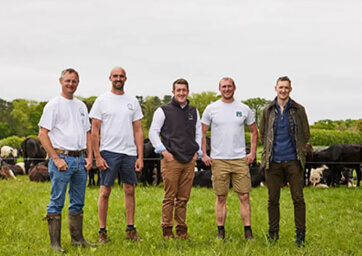
Because over the years, farming in the UK has changed beyond measure. It’s become an industry that manipulates and controls nature – with fertilisers, pesticides, one kind of crop on repeat, the land cut up into manageable chunks and animals fenced in.
This isn’t the farmers’ fault. It’s a broken system, right the way up the food chain. We’ve put cheaper food and ‘efficiencies’ before anything else, and farmers have often had no choice but to go along with it.
Regenerative farming is about going back to how farming used to be. It means following nature’s lead, carefully managing where animals graze, so fields have time to rest and nature can take over. It means looking after the soil, so it’s home to all kinds of insects, bacteria and fungi – and full of nutrients. It’s a focus on quality, not quantity, and following the seasons, not a spreadsheet.
We only know about all this because we started thinking more about our beef. And it turns out cows are a big deal on regenerative farms. Our farmers work with breeds that can grow and stay healthy simply by foraging in fields. It means they eat grass, legumes and leafy greens, not processed animal feeds. And they do a lot of good things, just by being cows…
First, they eat the plants. They also trample on them as they wander about, gently turning the earth as they go (a hoof is far better than a plough, because it doesn’t damage the soil). Then the farmer moves the cows to another field, leaving the first field to rest. Giving the land a break is one of the main things about regenerative farming, so nature can do her thing and the soil can recover.

Moving from field to field is better for the cows because, left to their own devices, they’d never stay in one place for a month. They’d move around in their herds, grazing in different places every few days. This is called ‘mob grazing’ and regenerative farmers manage it carefully.
It works for the plants too, because being eaten then left to rest means they’re always growing, so they take more CO2 from the air into the soil. Finally, cow pats are natural fertilisers, with all the nutrients the soil needs to stay healthy. Nature’s got her supply chain sewn up. The soil feeds the cows. The cows feed the soil (and us).

A field that’s left to rest isn’t empty. In fact, there’s a lot going on and its biodiversity – the variety of plants and animals in one place – increases. Our farmers let the grasses grow tall and leave ‘wild corners’ in their fields. This brings more bees and insects to the land, which then bring more birds and other mammals. Nature likes to mix things up and the farmers leave her to it.

We want more farmers to farm regeneratively, and we can reward them by paying a premium for their beef.
FIND OUT MORE
An introduction to our efforts to improve our supply chain and encourage farmers we work with to farm regeneratively.
FIND OUT MORE
Our land can no longer cope with intensive farming, we need to find a way to farm more sustainably.
FIND OUT MORE